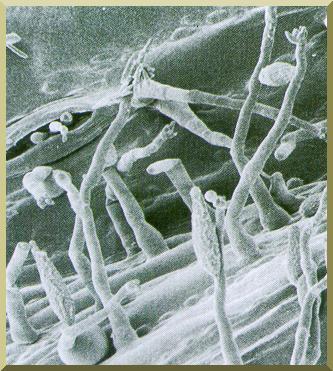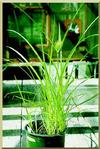|
|
|
|
| 1. GENERAL |
|
The "coquillo" or nutsedge is found as a weed in cultivated fields in the Ojos Negros valley, in Baja California. It belongs to the genus Cyperus, of which about 900 species have been documented throughout the world. Some are grown for food, fibers, and perfume; others are considered among the world's worst weeds. Two species are found in the Ojos Negros valley: C. esculentus L. and C. rotundus L. Based on the color of their flowers, C. esculentus L. is commonly known as yellow nutsedge, and C. rotundus is known as purple nutsedge. 1.1 Taxonomy The nutsedge belongs to the sedge family (Cyperaceae), and to the genus flatsedge (Cyperus L.). Its growth habit is graminoid, it is a perennial, apparently native to Eurasia, and it is introduced in the United States. The two most important species are: C. esculentus L. and C. rotundus L. Other common names are: nutsedge, nutgrass, cocosedge, cocograss, rednut sedge, coquito, and souchet rond. There are five botanical varieties of Cyperus esculentus: four wild varieties (esculentus, leptostachyus, macrostachyus, and hermanii) and one cultivated variety (sativus). This explains the existence of two groups of plants which have similar morphology and name, but differ in application: one is a weed and the other a crop. The nuts (tubers) of the yellow nutsedge are widely referred to as "chufa" nuts. Yellow nutsedge is known as chufa, yellow nutgrass, Northern nutgrass, nutsedge, earth almond, groundnut, tiger nut, zulu nut, rush nut, duck potato, or edible rush. Purple nutsedge is known by one of more common names in different places, including nutgrass, cocograss, "pakopako," "kili'o'opu," "chaguan humatag," "mustaka" or "musta" in Sanskrit, and "motha" in Hindustani. The plant is listed as a noxious weed by the U.S. federal government, and is considered a great menace to farmland in India. In Baja California, it is considered a nuisance in La Trinidad valley and in the Ojos Negros and Maneadero valleys. 1.2 History The use of yellow nutsedge has its origins in ancient Egypt. Chufa was one the first domesticated crops, having been found in vases in the tombs of the ancient Egyptian pharaohs. Chufa was widely used in Egypt and Sudan. Its dry tubers have been found in tombs from pre-dynastic times (4000 B.C.). The Arabs introduced the plant to Spain during the time of the Moorish kings (up to 1200 A.D.). The Eastern Spanish province of Valencia was the best for growing chufa. There are written records from the 13th century which mention the consumption of drink made from chufa (a predecessor to the horchata drink) in the region of Valencia. Yellow nutsedge occurs in most of the contiguous United States, where it now occurs in both natural and weedy habitats. In Canada, it was found primarily in native habitats prior to 1950. Over the last 40 years, yellow nutsedge has become weedy in cultivated fields. The spread of yellow nutsedge may correspond to the increased use of selective herbicides. 1.3 Overall Characteristics Nutsedges develop an extensive system of rhizomes, tubers, and roots. Rhizomes produce tubers and basal bulbs that bear aerial roots. Tubers store starch and have several buds that produce rhizomes, which develop more basal bulbs and new plants. Roots often grow to greater depths than tubers or rhizomes. Rhizomes are slender, fleshy when young, and covered with scales. Nutsedges reproduce vegetatively from tubers and by seed. Tubers and seeds disperse with agricultural and nursery activities, soil movement, and in water, especially flooding. Seeds also disperse with wind. Seeds and tubers germinate in spring. Tubers develop to soil depths of approximately 32 cm, but most are in the top 20 cm. One plant can produce hundreds to thousands of tubers in one season. Seed production can be high, but viability is variable; in California, seed viability is typically low. One plant can develop into a dense colony 3 m or more in diameter. Patch boundaries can increase by more than 1 m per year. A single tuber can produce nearly 2000 plants and 7000 tubers in one growing season. Very little nutsedge is produced from seed (less than 1 percent). Almost all of the nutsedge plants come from tubers that have been laying dormant in the soil or from tubers that have been brought in by contaminated sod, nursery stock, or machinery. Both nutsedges are able to survive in very diverse growing conditions. 1.4 Habitat Nutsedges occur in disturbed areas, cultivated fields, especially those irrigated in the summer; in irrigation ditches, orchards, vineyards, gardens, turf, and landscaped areas. They grow typically where moisture is plentiful. They tolerate many soil conditions, including periods of drought and flooding. 1.5 Chemical Control At present, yellow and purple nutsedge require different herbicides to control them; therefore, proper identification of the plants is vital. If the yellow nutsedge herbicide is used to control purple nutsedge, and vice versa, poor control of the targeted plants will result. There has been very little success controlling nutsedges using biocontrol methods such as fungi, insects, and nematodes. In turfgrass and ornamentals, mechanical control of the nutshedge is not feasible. At present there are four herbicides available for selective control of nutsedges in turfgrass: Basagran T/O, Daconate 6, Image and Pennant. In ornamentals, there are three herbicides available for the control of nutsedges: Basagran T/O, Pennant and Roundup. In turfgrass, Basagran T/O, Daconate 6, and immage are postemergence herbicides, while Pennant is used preemergence. Image and Daconate 6 are used for the selective control of purple nutsedge in most warm-season grasses. Image causes injury to cool-season grasses; at present there are no herbicides available for control of purple nutsedge in cool-season grasses. Basagran and Daconate6 are used for the selective control of yellow nutsedge in most cool-season grasses. In ornamentals both Basagran T/O and Roundup are applied postemergence, while Pennant is applied preemergence. Roundup, a broad spectrum herbicide, is used to control weeds such as nutsedges. Basagran T/O and Pennant are both used for the selective control of yellow netsedge in ornamentals. At present, there is no one herbicide available to control both nutsedges in all major turfgrasses. Since the nutsedges are not grasses, Fusilade/Venture, Past, Excel, or Assure will not be effective. 1.6 Other Control Strategies
This refers to the control of nutsedges by a hydrothermal process that utilizes the sun's energy to heat moist soil that is mulched under polyethylene. The basic concept of soil solarization is to use transparent, thermoplastic IR retentive films to allow transmission of light energy to the soil, where it is absorbed and used to heat the soil. Increased temperatures are achieved in this way. If the temperature under the plastic film and in the soil reaches sufficiently high temperatures, weeds, insects, and pathogens are damaged or killed. In arid cloud-free regions, the soil solarization technique has found wide application for the control of some soil-borne diseases and weeds. An experiment was performed in Western Australia to measure the effectiveness of soil solarization against fungi. Four weeks with soil temperatures at about 45oC where necessary to give good results against a certain fungi (Fusarium). If the temperature dropped below 45oC for 6-7 consecutive days, the treatment time had to be extended. Cloud cover had a marked effect on soil temperature under the plastic. With complete cloud cover and an air temperature of 34oC, soil temperatures of about 40oC were reached. However, in a cloudless day with air temperature at only 24oC, soil temperatures approaching 50oC would be achieved.
The fungus Dactylaria higginsii (Lutrell) M. B. Ellis has been identified by University of Florida researchers to control nutsedges. The method involves the use of the spores of the fungus applied to weeds to inhibit their growth or to induce mortality of the weed without adversely affecting the growth and yield of desired field crops. The fungus is very pathogenic to purple nutsedge.
|

| |
|
|
In certain parts of Tamil Nadu (Southern India), where rice is grown traditionally, farmers are effectively managing the nutsedge problem by using pigs. The pigs are of a local breed, dark black in color. They are allowed to collect the tubers in the wastelands. Since the tubers are succulent and sweet in taste, pigs are very fond of them. Nutsedge tubers are very nutritious food for pigs, increasing body weight and milk production. Pigs can easily remove the tubers even when the soil is hard. If the soil is wet and ploughed, it will be even easier for them to remove the tubers. Usually the field is soaked with water and puddled well when the animals are allowed to collect the tubers. Puddling will bring out the tubers buried in deeped layers (around 30 cm) and makes collection easier. Each animal can collect 2-4 kg of tubers in one day; 25-30 animals per acre (50-60 animals per hectare) can remove the available tubers within a day. Farmers around Virudhasalam village (Tamil Nadu) report that they practice this method every year before planting rice, and are able to control the nutsedge. In this way, purple nutsedge can be managed effectively without any harm to nature and without any additional weeding cost.
Limit tuber production and drain tuber energy reserves by repeatedly removing small plants before the 6-leaf stage (every 2-3 weeks in summer). Mature tubers can resprout up to about 12 times. Shading or solarization can reduce infestations by weakening shoots and decreasing new tuber formation, but mature tubers may not be eliminated. Cultivation (of nutsedge) can worsen an infestation if not repeated often enough to exhaust tubers and prevent new tuber formation. For purple nutsedge, deep cultivate thoroughly (to about 30 cm deep) to fragment tuber chains and cover green parts, followed by persistent repeated cultivation (to about 15 cm deep) to kill new shoots and limit new tuber formation, especially when the soil is dry.
|
| Yellow Nutsedge | Purple Nutsedge | Comparison | Sustainable Control Strategies |
| Strategies for the Ojos Negros Valley | Summary | Coquillo Facts |
|
http://ponce.sdsu.edu/three_issues_coquillofacts01.html
|
021104
|

